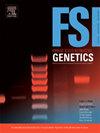Remains of the German outlaw Johannes Bückler alias Schinderhannes identified by an interdisciplinary approach
IF 3.1
2区 医学
Q2 GENETICS & HEREDITY
引用次数: 0
Abstract
Two mounted skeletons assigned to the famous German criminals Schinderhannes and Hölzerlips were on display at the Anatomical Collection of Heidelberg University for two centuries. However, doubts about their authenticity existed for decades. Based on historical research, an interdisciplinary team with experts from the fields of anatomy, radiology, anthropology, genealogy and molecular biology set out to examine the remains from the following perspectives: (1) Isotope analyses were carried out to compare inferred childhood residences with historical narratives, (2) anthropological and radiological examinations were documented and compared with historical records, (3) genealogical research identified a living male descendant along the maternal line and (4) mitogenome sequencing as well as nuclear SNP analysis using the FORCE panel provided compelling evidence for the identification of Schinderhannes’ remains. Additionally, the prediction of eye, hair and skin color from the DNA offered science-based data to clarify conflicting historical records.
德国亡命之徒约翰内斯·巴克勒(又名辛德汉内斯)的遗骸,通过跨学科的方法被确认
德国著名罪犯Schinderhannes和Hölzerlips的两具骨架在海德堡大学解剖收藏馆展出了两个世纪。然而,对其真实性的怀疑已经存在了几十年。在历史研究的基础上,一支由解剖学、放射学、人类学、家谱学和分子生物学专家组成的跨学科团队从以下几个方面对这些遗骸进行了研究:(1)进行同位素分析,将推断的童年住所与历史叙述进行比较;(2)记录人类学和放射学检查,并与历史记录进行比较;(3)家谱研究确定了一位在世的男性后代,以及(4)使用FORCE面板进行有丝分裂基因组测序和核SNP分析,为确定Schinderhannes的遗骸提供了令人信服的证据。此外,从DNA中预测眼睛、头发和皮肤的颜色为澄清相互矛盾的历史记录提供了科学数据。
本文章由计算机程序翻译,如有差异,请以英文原文为准。
求助全文
约1分钟内获得全文
求助全文
来源期刊
CiteScore
7.50
自引率
32.30%
发文量
132
审稿时长
11.3 weeks
期刊介绍:
Forensic Science International: Genetics is the premier journal in the field of Forensic Genetics. This branch of Forensic Science can be defined as the application of genetics to human and non-human material (in the sense of a science with the purpose of studying inherited characteristics for the analysis of inter- and intra-specific variations in populations) for the resolution of legal conflicts.
The scope of the journal includes:
Forensic applications of human polymorphism.
Testing of paternity and other family relationships, immigration cases, typing of biological stains and tissues from criminal casework, identification of human remains by DNA testing methodologies.
Description of human polymorphisms of forensic interest, with special interest in DNA polymorphisms.
Autosomal DNA polymorphisms, mini- and microsatellites (or short tandem repeats, STRs), single nucleotide polymorphisms (SNPs), X and Y chromosome polymorphisms, mtDNA polymorphisms, and any other type of DNA variation with potential forensic applications.
Non-human DNA polymorphisms for crime scene investigation.
Population genetics of human polymorphisms of forensic interest.
Population data, especially from DNA polymorphisms of interest for the solution of forensic problems.
DNA typing methodologies and strategies.
Biostatistical methods in forensic genetics.
Evaluation of DNA evidence in forensic problems (such as paternity or immigration cases, criminal casework, identification), classical and new statistical approaches.
Standards in forensic genetics.
Recommendations of regulatory bodies concerning methods, markers, interpretation or strategies or proposals for procedural or technical standards.
Quality control.
Quality control and quality assurance strategies, proficiency testing for DNA typing methodologies.
Criminal DNA databases.
Technical, legal and statistical issues.
General ethical and legal issues related to forensic genetics.

 求助内容:
求助内容: 应助结果提醒方式:
应助结果提醒方式:


